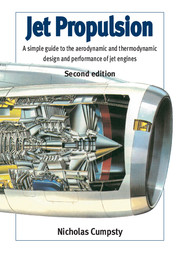 Jet Propulsion
Jet Propulsion Book contents
- Frontmatter
- Contents
- Preface
- Glossary
- Nomenclature
- Part 1 Design of Engines for a New 600-seat Aircraft
- 1 The New Large Aircraft – Requirements and Background
- 2 The Aerodynamics of the Aircraft
- 3 The Creation of Thrust in a Jet Engine
- 4 The Gas Turbine Cycle
- 5 The Principle and Layout of Jet Engines
- 6 Elementary Fluid Mechanics of Compressible Gases
- 7 Selection of Bypass Ratio
- 8 Dynamic Scaling and Dimensional Analysis
- 9 Turbomachinery: Compressors and Turbines
- 10 Overview of the Civil Engine Design
- Part 2 Engine Component Characteristics and Engine Matching
- Part 3 Design of Engines for a New Fighter Aircraft
- Part 4 Return to the Civil Transport Engine
- Appendix: Noise and its Regulation
- Bibliography
- References
- Index
- Design sheets for New Large Civil Aircraft and New Fighter Aircraft
4 - The Gas Turbine Cycle
from Part 1 - Design of Engines for a New 600-seat Aircraft
- Frontmatter
- Contents
- Preface
- Glossary
- Nomenclature
- Part 1 Design of Engines for a New 600-seat Aircraft
- 1 The New Large Aircraft – Requirements and Background
- 2 The Aerodynamics of the Aircraft
- 3 The Creation of Thrust in a Jet Engine
- 4 The Gas Turbine Cycle
- 5 The Principle and Layout of Jet Engines
- 6 Elementary Fluid Mechanics of Compressible Gases
- 7 Selection of Bypass Ratio
- 8 Dynamic Scaling and Dimensional Analysis
- 9 Turbomachinery: Compressors and Turbines
- 10 Overview of the Civil Engine Design
- Part 2 Engine Component Characteristics and Engine Matching
- Part 3 Design of Engines for a New Fighter Aircraft
- Part 4 Return to the Civil Transport Engine
- Appendix: Noise and its Regulation
- Bibliography
- References
- Index
- Design sheets for New Large Civil Aircraft and New Fighter Aircraft
Summary
INTRODUCTION
The gas turbine has many important applications but it is most widely used as the jet engine. In the last few years, since the regulations changed to permit natural gas to be burned for electricity generation, gas turbines have become important prime movers for this too. Many of the gas turbines used in land-based and ship-based applications are derived directly from aircraft engines; other gas turbines are designed specifically for land or marine use but based on technology derived for aircraft propulsion.
The attraction of the gas turbine for aircraft propulsion is the large power output in relation to the engine weight and size – it was this which led the pre-Second World War pioneers to work on the gas turbine. Most of the pioneers then had in mind a gas turbine driving a propeller, but Whittle and later von Ohain realised that the exhaust from the turbine could be accelerated to form the propulsive jet.
This chapter looks at the operation of simple gas turbines and outlines the method of calculating the power output and efficiency. The treatment is simplified by treating the working fluid as a perfect gas with the properties of air, but later some examples are discussed to assess the effect of adopting more realistic assumptions. It is assumed throughout that there is a working familiarity with thermodynamics – this is not the place to give a thorough treatment of the first and second laws (something covered very fully in many excellent text books, for example Van Wylen and Sonntag, 1985).
- Type
- Chapter
- Information
- Jet PropulsionA Simple Guide to the Aerodynamic and Thermodynamic Design and Performance of Jet Engines, pp. 30 - 46Publisher: Cambridge University PressPrint publication year: 2003
